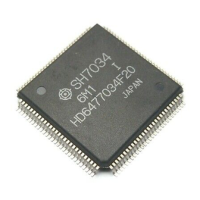157
Self-Refresh Mode: Some DRAMs have a self-refresh mode (battery back-up mode). This is a
type of a standby mode in which the refresh timing and refresh addresses are generated inside the
DRAM chip. When the RFSHE and RMODE bits in RCR are both set to 1, the DRAM will enter
self-refresh mode when the CAS and RAS signals are output as shown in figure 8.31. See sections
20.1.3 (3) and 20.2.3 (3), Bus Timing, for details. DRAM self-refresh mode is cleared when the
RMODE bit in RCR is cleared to 0 (figure 8.31). The RFSHE bit should be left at 1 when this is
done. Some DRAM vendors recommend that after exiting self-refresh mode, all row addresses
should be refreshed again. This can be done using the BSC’s CBR refresh function to set all row
addresses for refresh in software.
To access a DRAM area while in self-refresh mode, first clear the RMODE bit to 0 and exit self-
refresh mode.
The chip can be kept in the self-refresh state and shifted to standby mode by setting it to self-
refresh mode, setting the standby bit (SBY) in the standby control register (SBYCR) to 1, and then
executing a SLEEP instruction.
T
Rp
T
Rr
CK
RAS
CAS
T
Rc
T
Rcc
Figure 8.31 Output Timing for Self-Refresh Signal
Refresh Requests and Bus Cycle Requests: When a CAS-before-RAS refresh or self-refresh is
requested during bus cycle execution, parallel execution is sometimes possible. Table 8.11
summarizes the operation when refresh and bus cycles are in contention.

